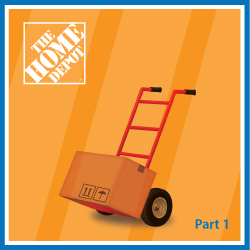
For companies selling any construction-related products, finding shelf space on the largest home improvement retailer, The Home Depot (HD), is a dream. All that exposure to the many customers shopping at the continually growing chain is hard to ignore, which is why many vendors apply to be put on HD’s shelves. Getting in and staying in requires a lot of work, but being available to its massive customer base is the ultimate payoff.
In Part 1, we’ll look at how to land in the store; Part 2 we’ll explore how to succeed in the stores themselves.
Who Are You Selling to?
Its customers vary in age and purpose. Most are baby boomers, but millennials, eager to take on DIY jobs, are increasingly shopping at the chain. Further, many buyers use the store for professional uses. Contractors make up just 3% of HD’s base, however they generate 40% of the store’s revenue; easily making them HD’s most valuable customers. HD does well appealing to both homeowners and professionals. This will be something to consider when deciding your marketing strategy if you manage to land on HD’s shelves. Should you focus on professionals, non-professionals, or both?
But before you can consider that, you need to land yourself a place in Home Depot’s aisles.
How to Pitch Yourself to The Home Depot
Obviously if you aren’t yet selling at The Home Depot, finding your way into their list of suppliers is the place to start. You’ll need to carefully plan your pitch and work hard to stand out to grab this retail giant’s attention.
What is The Home Depot Looking for?
Innovation is one of the most important criteria that HD Merchants (the people you’ll often be pitching to) look for. What is pain point are you looking to solve? How/why is your product the solution? What differentiates it and makes it so innovative compared to your competition? These are all questions to ask yourself and try to understand before bringing a pitch to a Merchant. Without successfully answering these questions, how can you expect them to ever get excited about your products?
To understand the category you’ll be competing in, research significantly. One great place to research? HD itself. Look through your product category on their website to check out the competition; walk the aisles in HD stores to see how they’re presented. This wealth of information helps you understand your place in the category and what you need to do to differentiate yourself from competitors.
Do the Bare Minimum and Apply Online
Compared with in-person pitches, applying online can be a little easier; it’s a step you should take at the bare minimum. This is a step every potential vendor should take and can lead to HD selling your merchandise, but you shouldn’t stop there. Do anything you can to directly talk to one of the company’s Merchants if you’re really determined to get shelf space.
Take Advantage of Special Events
Trade shows and Home Depot “Buying Days” can help you stand apart from the sea of new product submission requests. With some preparation, you can secure your role as an HD vendor.
Trade shows, like the National Hardware Show, attract big retail names looking to find the newest innovations to include in its stores. 83% of NHS attendees say that new products are a primary reason for attendance and 86% plan on sourcing new products from the event. So HD is entering these trade shows looking to find new vendors, meaning attending gives you the opportunity to directly pitch to the company.
Setting up a booth and being well-prepared to pitch will work to your advantage. Want to go one step further? Host an educational seminar or some other memorable event during the show. This will drive interest to your company, making it more likely to attract HD or another big-name retailer.
Further, HD “Buying Days” also give you direct exposure to HD’s merchandising department. Similarly, be well-prepared in your pitch and take advantage of your time with this face-to-face pitch.
The Key to the Pitch: Preparation and In-Person Opportunities
Above all else when pitching, know what you’re doing. Know your product, know how you compare to others in your category, know what HD is looking for. Further, submitting your new product online may work, but it likely won’t be enough. Do whatever you can to get face-to-face with someone from HD’s merchandising team. This isn’t the end of your Home Depot success, however. Once you’re in, you need to entice customers to buy your products and convince The Home Depot that you’re worth keeping around. Check out Part 2 to make the most of your position in-store.
